By 1907, the 12" gun had reached the limits of its development. Trying to improve range and penetration by throwing projectiles faster was clearly a losing game, so calibers began to creep up again. The British lead the way with a return to the 13.5" gun, to replace the 12"/50 used on some of their later first-generation dreadnoughts.
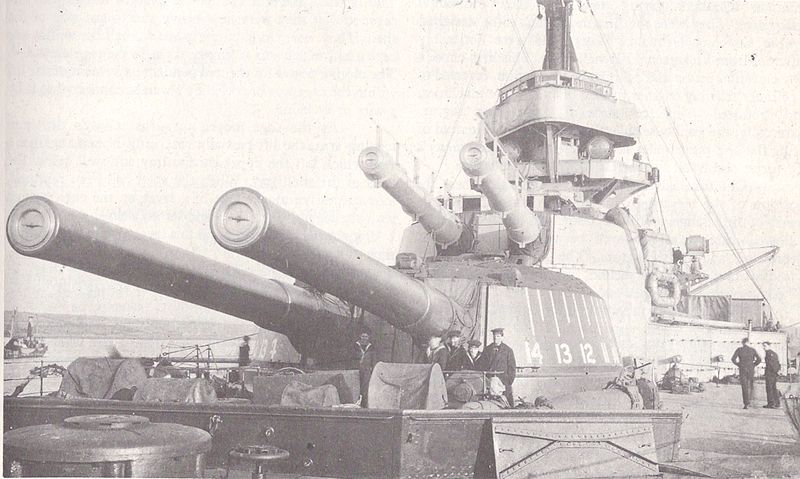
13.5" gun on HMS Ajax1
Besides the accuracy issues already discussed, the 12"/50 suffered from an absurdly short barrel life. As a gun is fired, the hot gasses melt and erode the bore. This is more of a problem for high-velocity guns, and on the British 12"/50, the liner was worn out and had to be replaced every 130-160 rounds.2 The 13.5"/45 that replaced it saw a significant reduction in muzzle velocity, from 2850 ft/s to 2580 ft/s, but an increase in barrel life to a full 450 rounds.3 Thanks to the improved ballistics of the heavier shell, the two projectiles were traveling at the same velocity by the time they reached 15,000 yards.
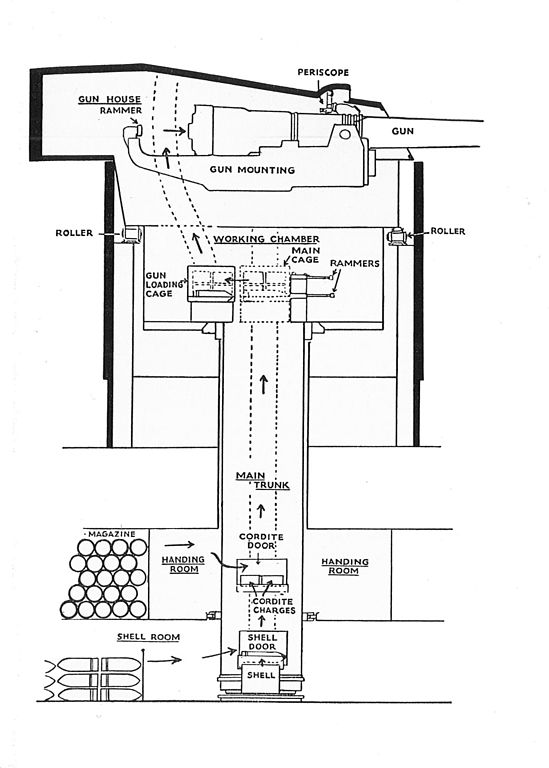
Turret and loading path similar to those on 13.5" guns of the Colossus class
It was soon realized that the British designers had been overconservative after the failure of the 12"/50, and that the 13.5" gun could be pushed further by using a heavier shell, at an acceptable cost in barrel life. The gun itself remained unchanged, although the hoists and other handling gear had to be modified to accommodate the longer shell. Below is a table comparing the 12"/50, the 13.5" with both the original 1,250 lb shell and the later 1,400 lb shell and the 15"/42 the British adopted to replace it.
| 12"/50 | 13.5"/45 (L) | 13.5"/45 (H) | 15"/42 | |
|---|---|---|---|---|
| Shell Weight (lb) | 850 | 1250 | 1400 | 1920 |
| Muzzle Vel. (ft/s) | 2852 | 2582 | 2491 | 2467 |
| Penetration, muzzle | 16.8" | 17.3" | 17.3" | 18.0" |
| Velocity, 10 kyrd | 1821 | 1750 | 1783 | 1850 |
| Penetration, 10 kyrd | 11.2" | 12.2" | 12.5" | 14.0" |
| Barrel Life | 130 | 450 | 220 | 335 |
The Germans took a very different approach, using 11" guns on their first dreadnought class, and then 12"/50 guns on all of their ships until the Bayern class of 1913. This gun surrendered only about 50 ft/sec to its British counterpart, and fired a 895 lb shell, but had a barrel life of approximately 200 rounds.
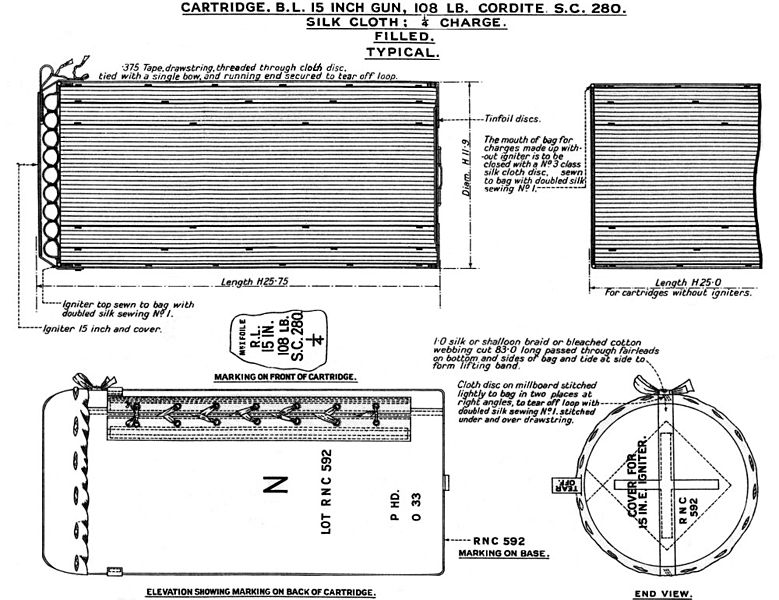
Cordite charge for 15" Mk I gun
The increased barrel life relative to the British 12"/50 was for two major reasons. First, the Germans were world leaders in metallurgy, while British industry was rather conservative. Second, the Germans used much cooler-burning powder, while the hot British cordite tended to cause rapid erosion. Despite this, it was still relatively short by British standards, although that might have been more acceptable to the German Navy, which was chronically cash-strapped, and thus much more economical with training than the RN. Ships were traditionally regunned when the barrel life was less than the per-gun ammunition capacity, to ensure that the gun was accurate at the end of a battle. Going from 130 to 200 rounds of accurate fire was thus a major improvement for ships which traditionally carried around 80 rounds per gun.
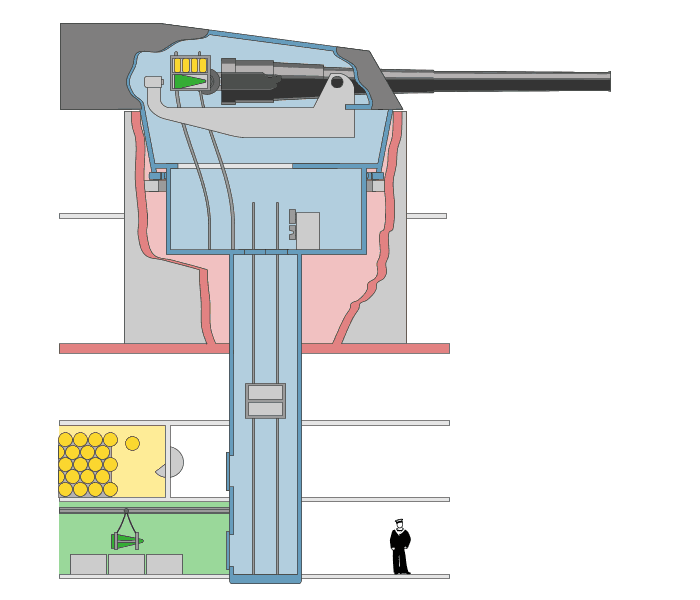
Animation of 15" Mk I turret
Of course, not everyone was willing to sit out the caliber race the British had started. The Americans and Japanese trumped the British with 14" weapons starting around 1910. Winston Churchill, then the First Lord of the Admiralty,4 was willing to continue, upgrading to 15" on the Queen Elizabeth class. No such gun existed, and he was gambling the fate of the 5 newest British battleships on it working. If the gun had proved a failure, the ships would have been armed with only 8 13.5" guns, a step down relative to their predecessors. Fortunately for him, and for Britain, it was a gamble that paid off handsomely, as the 15" Mk I was probably the best battleship gun of World War I. Accurate, reliable, and effective, it was also the armament of the last British battleship, HMS Vanguard.5
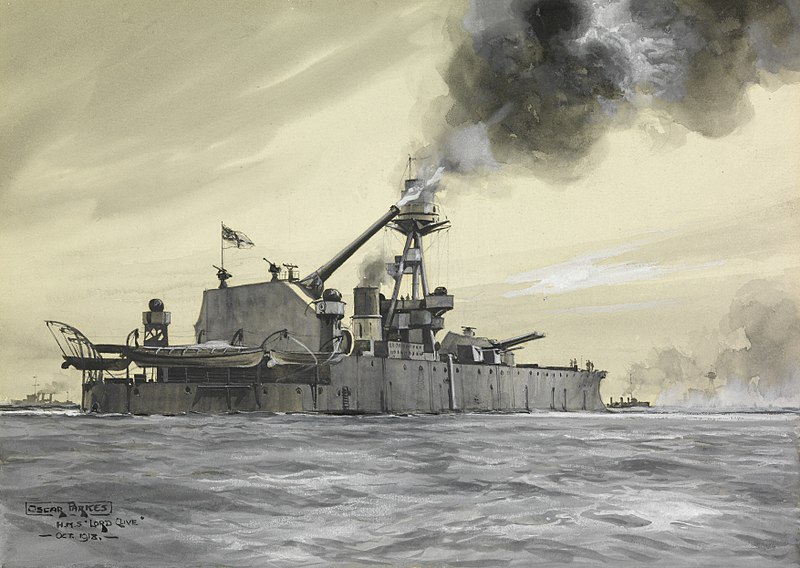
Monitor Lord Clive firing her 18" gun
WWI intervened, freezing British capital ship construction, although they'd already begun plans for an 18" gun, which ended up only being mounted on HMS Furious and some monitors.6 As it was, the next step came again from the Americans and Japanese, who both went to 16" for their ships starting around 1916. This limit was later enshrined by the Washington Naval Treaty, and the British built their only 16" battleships in the early 20s, the Nelson class.
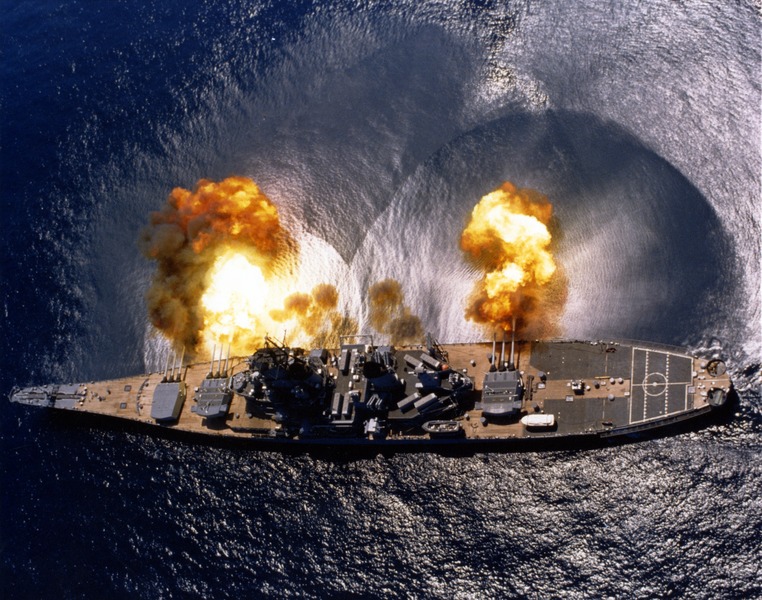
Muzzle blast illustrated
As interesting as the guns themselves is how they were put on the ships. While it's easy to talk about fitting 8-12 guns aboard a ship, doing so in a way that allows the maximum number of guns to be brought to bear while avoiding structural problems and blast interference is surprisingly difficult. For structural reasons, turrets are most efficiently placed on the centerline, directly above the keel, but space there is limited. Heavy naval guns produce significant overpressure. A British 12" gun7 produced 30 psi of overpressure at 150' directly in front of the muzzle, and at about 70' directly beside the muzzle. 30 psi is enough to cause severe lung hemorrhage in people, and do severe damage to even reinforced concrete and seismic structures.8 This makes finding safe places for all of the other stuff that needs to go aboard a warship, everything from secondary guns to boats to bridgework, rather tricky.


Hexagonal (above) and Dreadnought turret arrangements
Many of the later pre-dreadnoughts had been fitted with wing turrets, cantilevered out to the sides of the ship. These were structurally inefficient and could only fire on one side, but were fairly common on early dreadnoughts, too. Dreadnought herself had 5 twin 12" turrets, one forward, two wing turrets, and two aft, both on the same level. In theory, this arrangement gave 8 guns on either broadside and 6 guns forward or aft. In practice, firing the wing guns close to the centerline was not popular due to blast damage. The original plan had been to use a 6-turret hexagonal arrangement, but the aft pair had been consolidated due to blast interference. The hexagon was later used by the Germans and Japanese on some of their battleships.
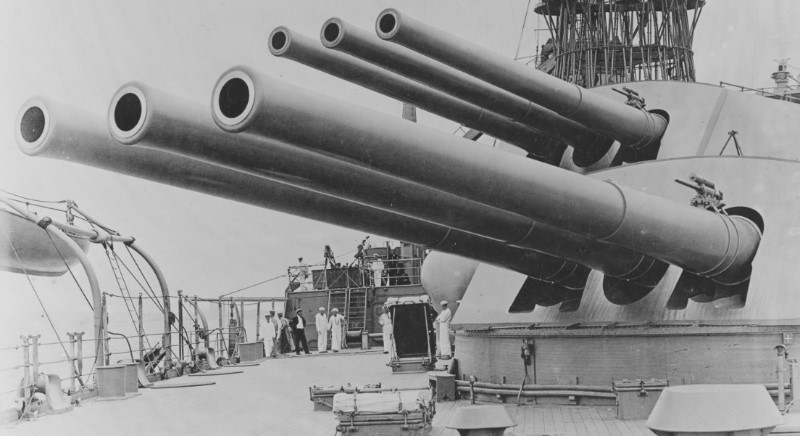
Superfiring turrets on USS Pennsylvania, with sighting port cutouts visible at the lower left and right corners of the wing gun ports
The American South Carolina used a different system to gain an 8-gun broadside, with only four turrets. Two turrets were forward, and two aft, with the second and third turrets elevated so that their guns trained over the outer turrets on each end. This arrangement, known as superfiring, was not adopted by the British due to concerns about blast effects on the lower turret if the upper turret was fired near the centerline. The Americans, who were less concerned with end-on fire, adopted the arrangement to meet restrictions on ship size. One major factor in this was the different placement of sighting ports. The British placed their sights in the roof of the turret, which made them vulnerable to blast effects. It wasn't until HMS Hood that the superfiring turrets were able to fire within 30° of the centerline. The Americans placed their sighting ports in the turret face, which was obviously much less vulnerable to blast.
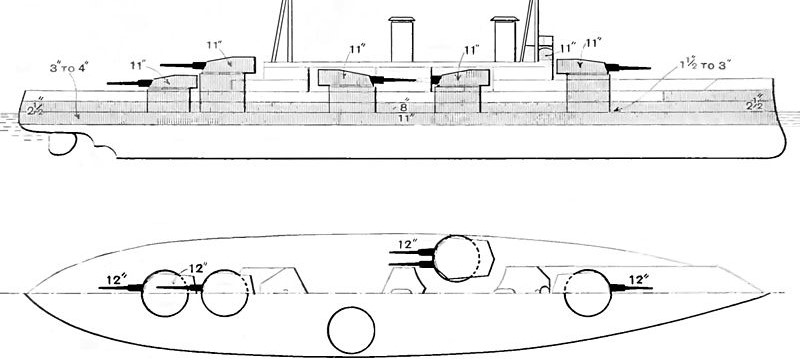
HMS Colossus, showing staggered wing turrets and superfiring turrets aft
The biggest disadvantage of Dreadnought-style wing turrets was that one turret would always be out of action, at a considerable cost in weight. In an attempt to balance the advantages of wing turrets in end-on fire, the British produced the staggered wing turrets used in HMS Invincible and later on many battleships and battlecruisers worldwide. This was similar to the staggered turrets of some ironclads, where one wing turret was placed in front of the other, leaving gaps through which each turret could in theory fire across in the ship. In practice, of course, blast meant this was not a popular procedure, and on some ships was considered to be so dangerous that it was seen as more of an emergency capability in case the turret on the engaged side was disabled. Finally, around 1910, designers began to place all of the guns on the centerline.
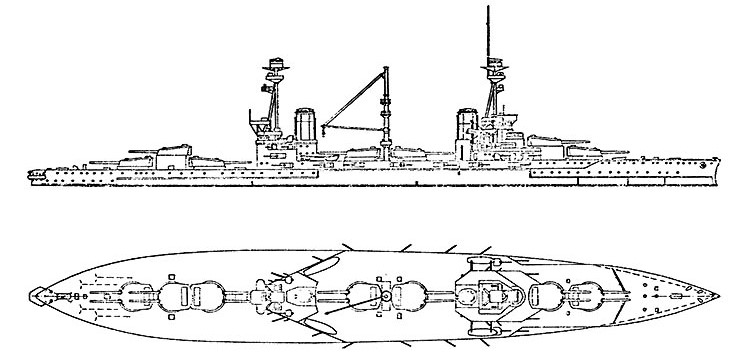
HMS Agincourt, the ultimate turret farm
This wasn't a final solution to the problem of packing heavy guns onto ships, though. To go above 8 guns with twin turrets meant that space for fifth and sixth turrets had to be found on the centerline. This caused lots of problems on the resulting "turret farms". Often, steam pipes had to be routed around magazines, which resulted in uneven powder temperature and poor accuracy. It drove up weight and left little space for things like boats, which needed to be clear of blast. The most extreme of these ships, HMS Agincourt, had 7 twin turrets on the centerline.
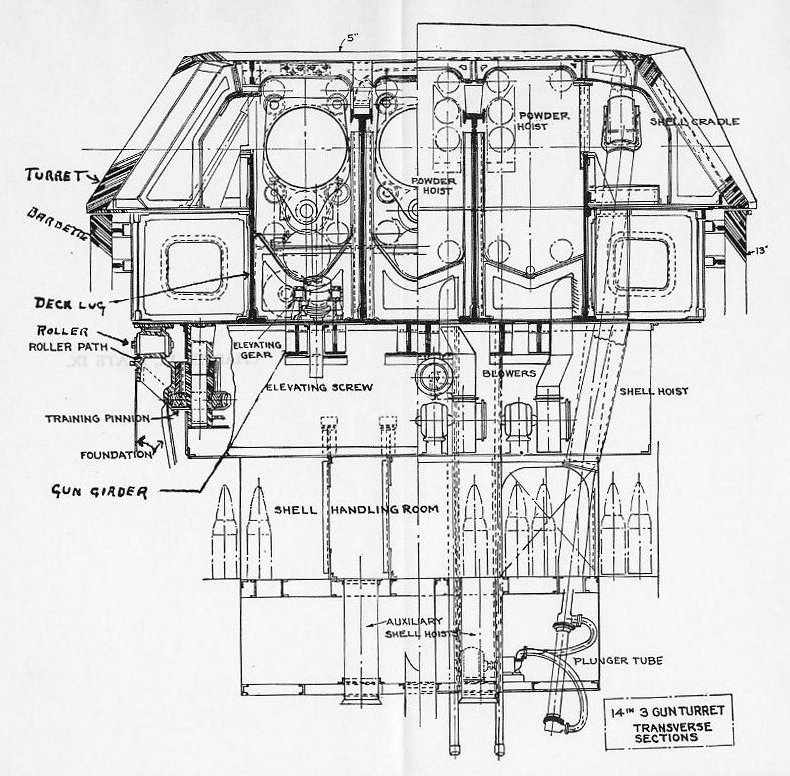
US 14" 3-gun turret
The alternative to cramming on more turrets was to enlarge the turrets and fit more guns in each one. Besides saving considerable centerline space, a pair of triple turrets were considerably lighter than three twins. The major downside was that a triple turret is more complicated and slower-firing than a twin, as more is going on in a relatively smaller space, and there's no nice and symmetrical way to lay it out. A hit on a triple also disables more of a ship's firepower than a hit on a twin, but the tradeoffs were usually worth it. The Italians were the first to lay down ships with triple turrets, but they were soon joined by the Austro-Hungarians, Russians, and Americans.9 The British, Germans, and Japanese stuck with the twin through the end of WWI, while the French went straight to quadruple turrets for the Normandie class, cancelled because of the war. Triple turrets allowed sufficient firepower to be packed into the 4 turrets which could be easily fitted aboard a battleship.
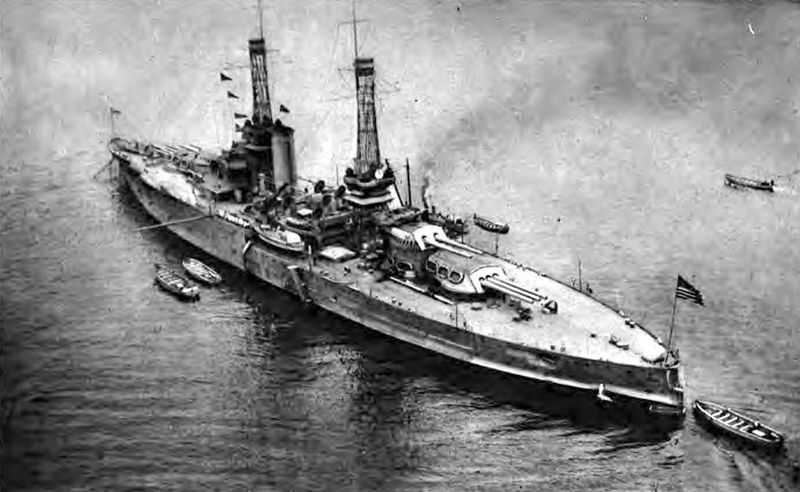
USS Nevada showing 2-gun turret superfiring over triple turret
Before WWI, naval guns developed rapidly, reaching unprecedented heights of caliber, shell weight, and velocity. The practice of mounting them aboard ships also improved, from the inefficient wing turrets to the superfiring triples of the US Standard Type. Next time, we'll examine the development of guns after WWI, to the pinnacle of the type on the Iowa.
1 Note the concentration marks on the forward turret. These were intended for cases where one ship in a group could see the enemy, to give bearing information to the other ships. A separate concentration dial transmitted range. ⇑
2 Navweaps credits this gun with only 75-80 rounds, but I've checked all of their references and none of them give that number. ⇑
3 Interestingly, the 13.5" actually used a lighter cordite charge than the 12"/50, 293 lb instead of 307 lb. ⇑
4 The civilian head of the Royal Navy, equivalent to the US Secretary of the Navy. ⇑
5 Particularly for the British during WWII, gun mountings were the limiting factor in ship construction. They had four 15" mounts left over from WWI, and placed them into a new hull. Vanguard was known as "The battleship with her great aunt's teeth." ⇑
6 Ships armed with heavy guns for coastal bombardment, but not intended to fight other ships. ⇑
7 It may have been the 12"/35 Mk VIII based on the date of the source, but the caliber isn't listed. On the other hand, the values here match a diagram in Warrior to Dreadnought based on the one used to lay out Dreadnought, which had 12"/45s. ⇑
8 Data from the Nuclear Bomb Effects Computer, 1977. I'm not 100% sure that the two types of pressure are equivalent, but it's the best source I have to hand. Suffice it to say that 30 psi overpressure is not something I'd want to be exposed to. ⇑
9 The US introduced an unusual twist on the triple. Most turrets had guns mounted in separate slides, allowing them to elevate individually. The US developed a variant that mounted them in a single slide. This made the turret smaller, but limited rate of fire as all the guns elevated together. A major driver of this was the US practice of firing full-broadside salvoes, as opposed to the British, who fired split salvoes (one gun from each turret). The single slide was soon dropped from battleship use, although it did bring about a quirk of US terminology. In US technical terms, a "triple" is a turret with 3 guns and one slide, while a "3-gun" is a turret with 3 guns in separate slides. This does not apply to other nations, and even within the US, it's not always adhered to that well. ⇑

Comments
I can neither spot what I'm supposed to notice as a "concentration mark" in that photo, nor am I clear how the targeting info is being forwarded :(
This paragraph is also confusing:
If I'm reading your facts right, the Germans have a shorter barrel life (200 vs 400?), despite better metallurgy and cooler powder? And they're OK with it because they fire less? IDK, you might consider rewriting that small section.
The comments on overpressure and safety remind me of somthing I've wondered: to what extent is it safe to be on deck (anywhere) during a battleship engagement? (Putting aside the obvious fact that you're presumably getting shot at.) I know we need men in the tops to spot and rangefind, but the guns would seem to put up huge no-go zones, unless i'm missing some trick sailors used to be safe there.
In particular, in WW2-era engagements when there were, what, 120+ uncovered and manned AA guns, how do the gunners not get killed by the main gun fire?
The markings are the numbers painted on the side of the turret. Other ships look at them to get bearing information.
It's not 200 vs 400, it's 200 vs 80. The 13.5" and 15" were much less aggressive guns than the 12"/50.
And basically nowhere. The guns on deck were a major limit to main guns arcs.
To expand on my earlier replies (written in a hurry on mobile): Basically, the numbers on the turrets let other ships in the squadron look at one ship and see the bearing it’s shooting on. I’m not sure what the reference point is. Looks like it might be 18 (presumably 180) is dead ahead, which is a bit weird, but might be a reciprocal thing. One ship being able to see while the others can’t was pretty common at Jutland due to fog.
The comparison there is between the 12″/50s of both nations. The British 13.5″ and 15″ were much cooler guns, and got barrel life that way, and range and power by being big. The Germans made the small, fast gun work much better than the British did.
This was a big deal. Initially, the battleship designers struggled a lot to find places for boats, and later AA guns and planes, that were not too badly affected by the blast of the main guns. During the war, the changing balance between AA and surface action forced guns to be put in worse and worse places, which limited firing arcs. But the only case I know of of air and surface combat going on at the same time was Samar, and that was a really weird situation.